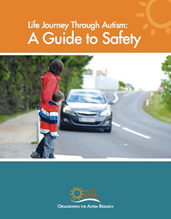
Press Release: OAR Awards 10 Graduate Research Grants in 2025
ARLINGTON, VA, July 9, 2025 – The Organization for Autism Research (OAR) is delighted to announce the recipients of its...
These recommendations from OAR’s “A Guide to Safety” can help you steer your adolescent in a healthy and safe direction.
Luke is a teen with autism spectrum disorder (ASD). Like any other teenager, dating and relationships are something he thinks about a lot. Like many of his peers with ASD, he doesn’t understand the unspoken rules of relationships. That lack of understanding led him to call, text, and follow a girl at school whom he liked, despite repeated requests by the girl to be left alone. Although Luke simply wanted to enjoy her friendship, ultimately a restraining order was issued because of his inappropriate behavior.
Luke is fictional, but his story is one that many parents of children and teens with ASD worry could become theirs. That’s why sexuality and relationship education is extremely important. As a parent, you are your adolescent’s most trusted authority on relationships and can steer your adolescent in positive, healthy directions.
OAR’s “A Guide to Safety” offers three core recommendations for parents to help their children stay safe and enjoy healthy  relationships.
relationships.
Learn social skills. The “hidden curriculum” of body language, facial expressions, and rules that make relationships complex can be difficult for all teens to wrap their minds around, but it can be especially hard for teens with autism to grasp. Targeted social skills instruction will help ensure that your teen knows how to interact with peers in a positive and productive manner, with fewer opportunities for misunderstandings. Help your teen learn how to say no to different types of inappropriate advances—with words, body language, or actions (like walking away). Always encourage your child to talk to you or another trusted adult immediately if something inappropriate happens.
Understand the key aspects of relationships. It is critical that your teen learns about the different levels of relationships—from stranger to romantic partner. All relationships have appropriate behaviors, conversation topics, and established (but rarely spoken about) boundaries. Explain the differences in an explicit way so that your adolescent can develop realistic expectations for the relationships in his or her life.
To keep your adolescent safe from abuse or being taken advantage of in a relationship, it is really important that he or she knows what abuse can look or sound like—name calling, making comments about body parts, grabbing, touching, or being shown inappropriate pictures. Sometimes, abuse comes in the form of bribes and threats—“If you do XYZ, then I’ll give you an ice cream,” or “If you tell anyone about ABC, then I’ll hurt your parents.” In this context, make sure your adolescent knows that:
If something does happen, your adolescent should understand that it wasn’t his/her fault first of all. Adolescents should always know that they will not be punished for telling a trusted adult if something happens to them. Make sure your teen knows to take the following steps:
Participate in sexual education. Sexuality education starts at home, as you and your adolescent work together to learn about the body, puberty, public versus private behaviors, relationships, etc. Make sure this learning process incorporates the beliefs and values that are important to your family. Of course, you also can coordinate sexuality education with the school or with any of the professionals who work with your teen. Regardless of where you decide to approach the subject, make sure that intercourse is not the only item on your “sex ed” agenda; sexuality education is about more than that.
Teens with autism can get in trouble with schools and law enforcement because, though they experience the same sexual feelings as their peers, they may be confused about how to act on them. For example, an infatuation with a school peer may lead to behaviors that might be perceived as stalking, even if your teen has no intention of “being creepy” or making someone feel uncomfortable. Some individuals need to be taught not to touch other people, stare at other people, or make comments of a sexual nature to people whom they do not know. The more preparation and information your adolescent has about his/her own sexuality, the safer and better prepared he/she will be.
The more that adolescents knows about their body and the different types of relationships in which they may find themselves, the better prepared they will be to make safe decisions. The more you know about how to help your teen, the better you will feel about the decisions he or she makes.